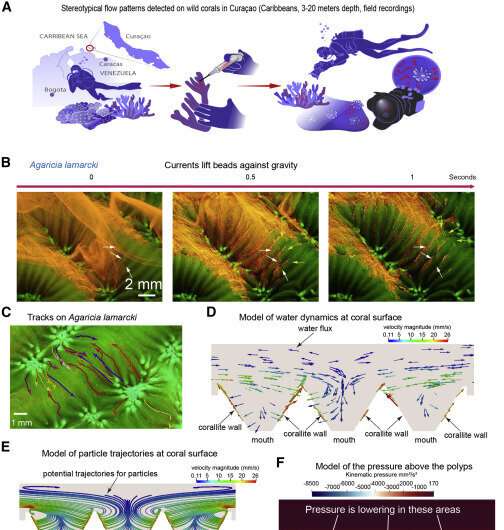May 13, 2022 report
Cilia on coral reef polyps found to generate horizontal currents

A large international team of researchers has found that cilia on coral reef polyps generate horizontal currents that are used to carry mucus across the surface of a reef. In their paper published in the journal Current Biology, the group describes how they discovered the currents generated by the cilia and experiments they conducted to learn more about their purpose.
Prior research has shown that cilia on coral reef polyps create tiny vertical currents that push seawater and anything it contains away from the surface of the coral, likely as a means for removing microbes that could cause harm, along with other debris. In this new effort, the researchers found that the cilia also generate horizontal currents that carry mucus created by the coral across its surface.
The researchers acknowledge that they discovered the existence of the currents by accident. They were conducting research on corals for another project that involved the use of fluorescent beads and happened to notice that the beads were moving in what they describe as "interesting ways." Intrigued, they took a closer look.
The researchers started by placing their beads on other corals and found that the movements were present in all of them. They next added black beads and began creating videos of the action. Next, they created a model of the movement of the beads and other particles in the water around them. They found that each of the corals created a unique current across its surface.
The researchers suspect that the purpose of the current is to coordinate food distribution across all of the polyps on a given coral. They note that their model showed that each of the polyps shared food with neighboring polyps, suggesting dedicated regions of food sharing—an arrangement that would lessen competition for food between the polyps.
The researchers acknowledge that more work is required to validate their study because they used beads instead of actually tracking the movement of food. They also suggest their research sheds light on how corals work, which could help to preserve them as climate change threatens their existence.
More information: Thibault Bouderlique et al, Surface flow for colonial integration in reef-building corals, Current Biology (2022). DOI: 10.1016/j.cub.2022.04.054
Journal information: Current Biology
© 2022 Science X Network





















